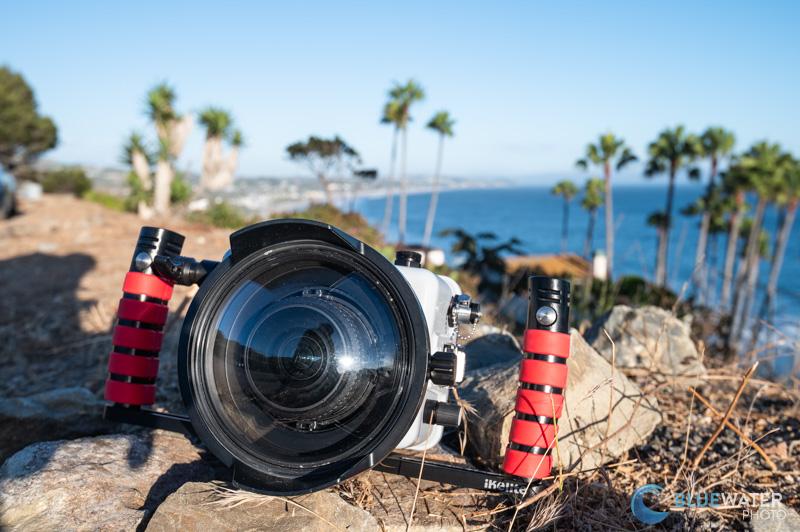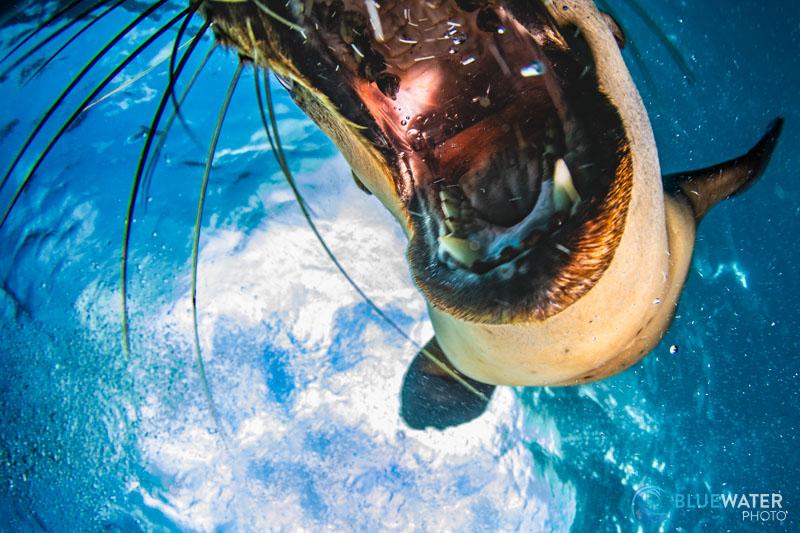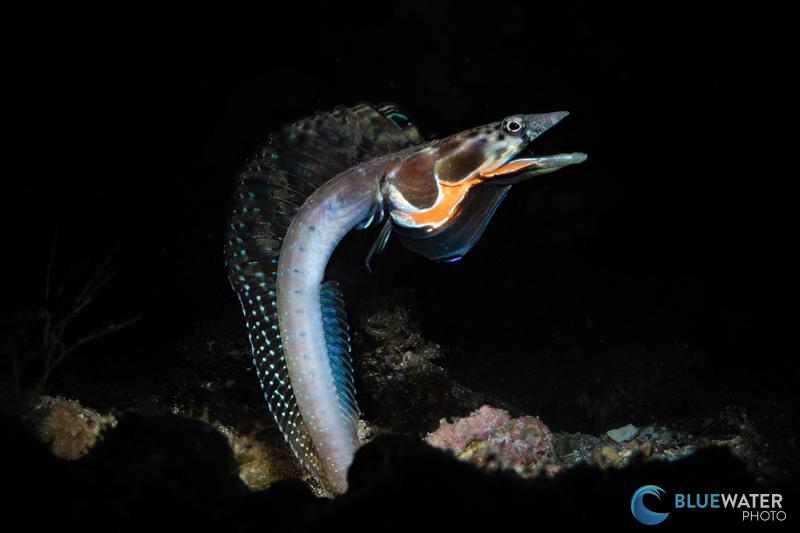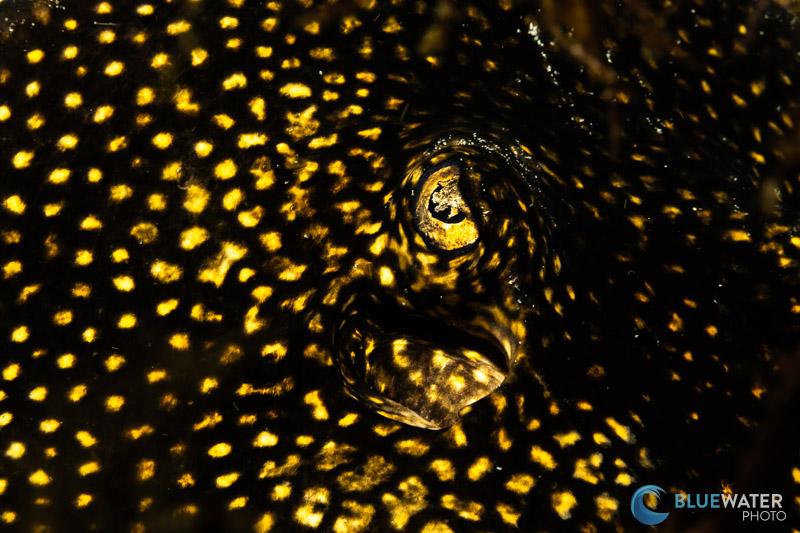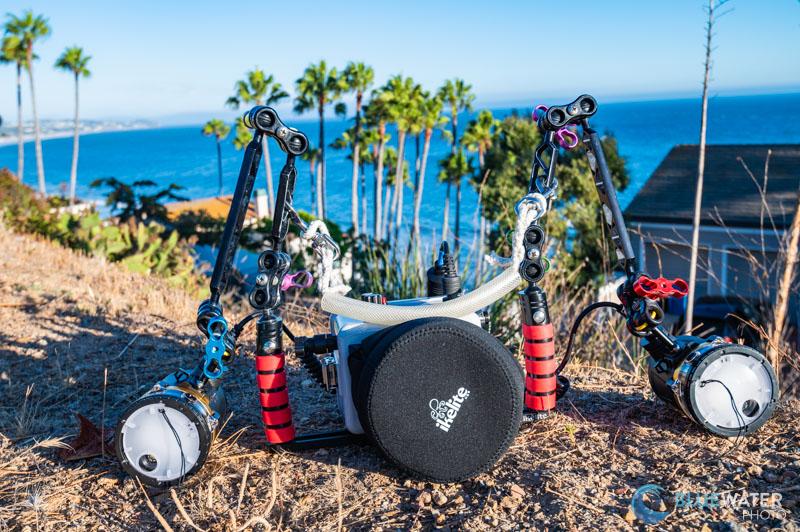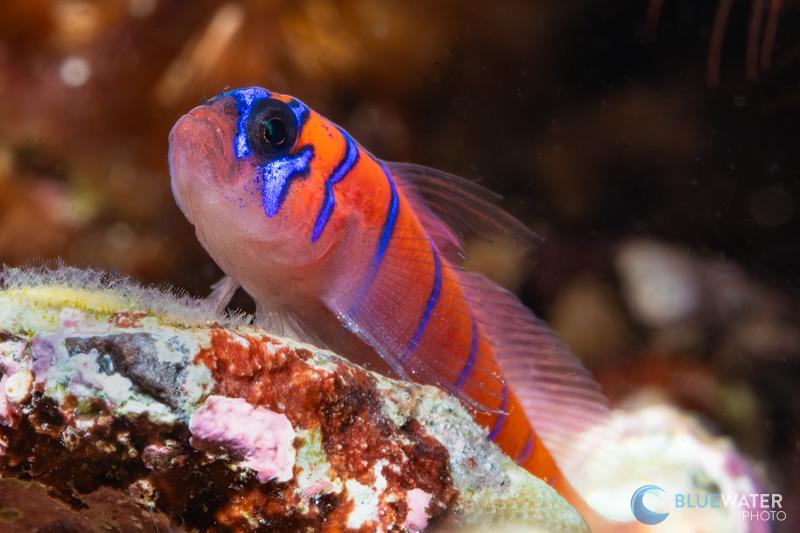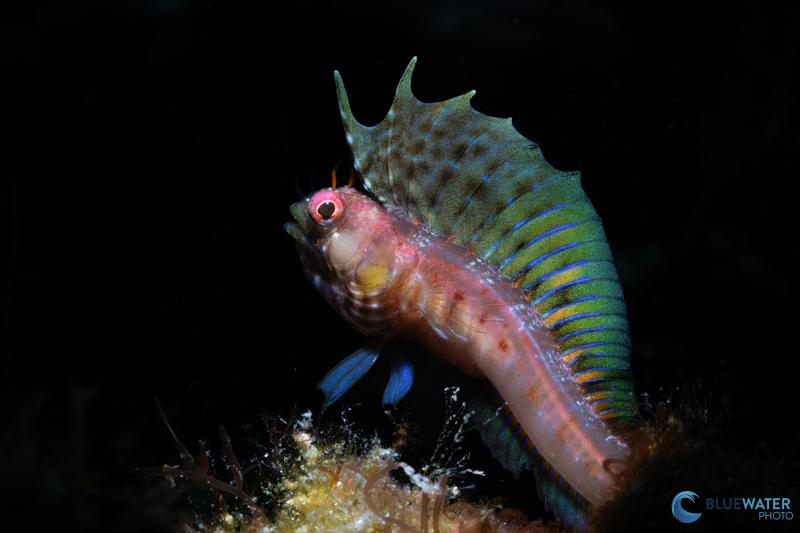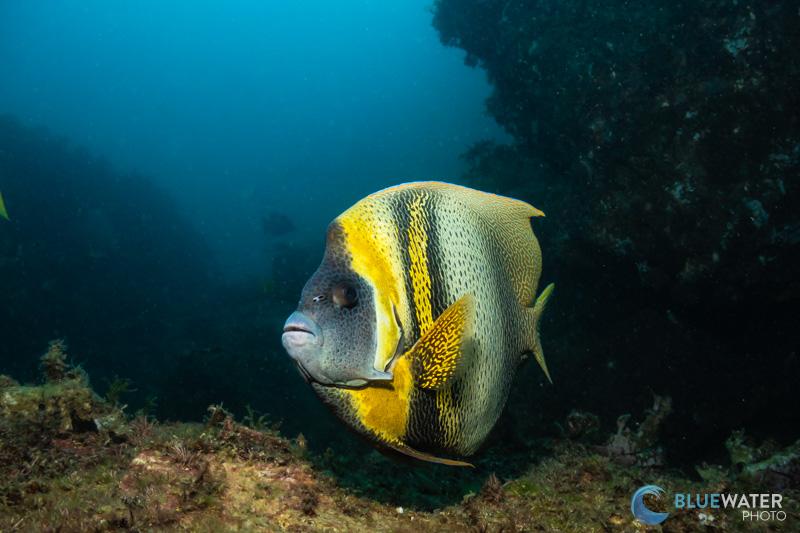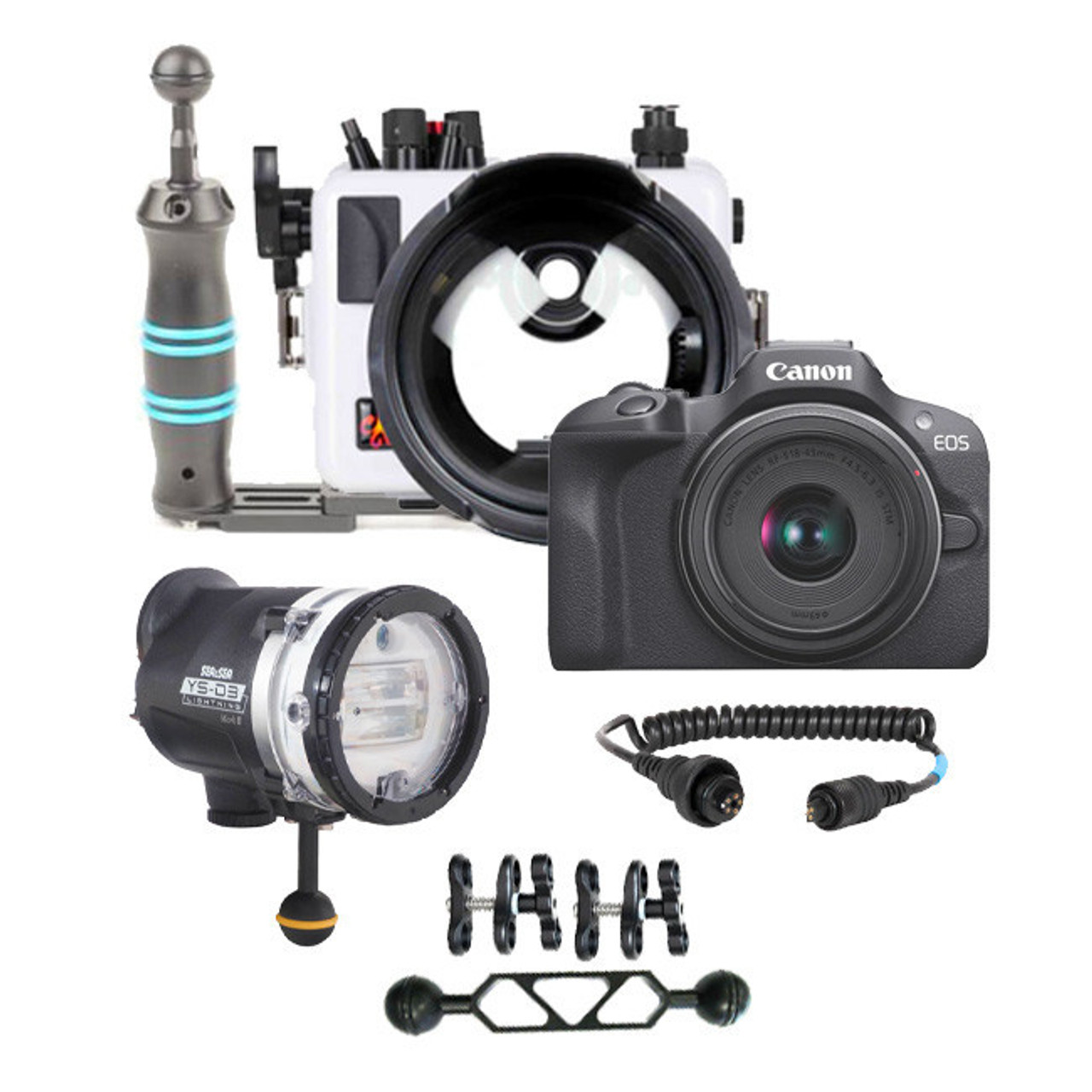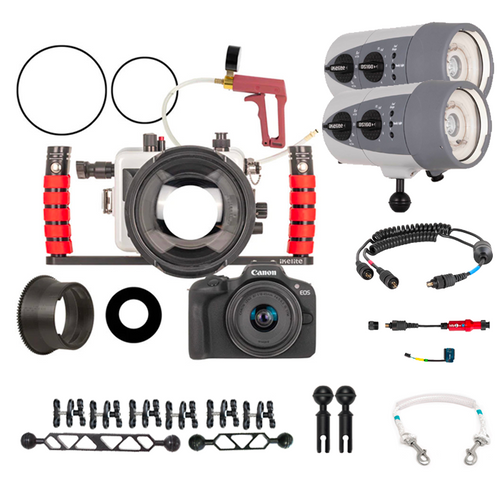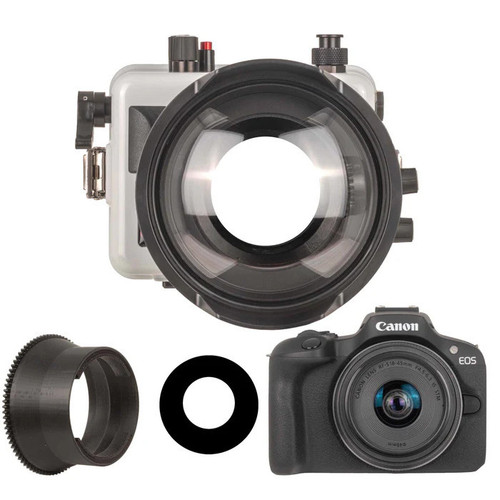
The Canon EOS R100 emerges as a game-changer for underwater photography, ushering in a new era of affordability. As compact cameras like the OM System TG-7 experience a surge in prices due to the growing popularity of smartphones, larger sensor cameras are becoming more enticing with decreasing overall costs. In this evolving landscape, mirrorless cameras, particularly those featuring APS-C sized sensors, are taking the spotlight.
Amidst this shift, the Canon R100 stands out as the most budget-friendly APS-C mirrorless camera, priced at a mere $479.99 for the camera body. This is a noteworthy contrast to the rising costs of compact alternatives. The R100 positions itself as a formidable contender, offering superior dynamic range, low-light performance, and detail—a testament to the advantages of its larger sensor.
Bluewater’s starter package for the R100 further sweetens the deal, bundling everything needed for both underwater photography and videography at an incredibly competitive price of just under $2900. This comprehensive package caters to enthusiasts seeking a cost-effective yet high-quality solution for capturing the wonders beneath the waves.
Initially skeptical about the R100’s affordability, especially given my positive experience with the Canon R10, I found myself pleasantly surprised after extensive use in the Sea of Cortez and Southern California. Contrary to expectations, the R100 doesn’t compromise on image quality. In fact, it earns the title of the “most affordable underwater camera system ever,” surpassing its predecessor, the R10, in delivering unparalleled image quality per dollar.
For those prioritizing cost-effectiveness without compromising on visual excellence, the Canon R100 is a compelling choice. The accompanying images vividly demonstrate its prowess, reinforcing the R100’s status as a game-changing and budget-friendly option in the underwater photography arena.
Jump to a Section
Canon R100 Specs | Canon R100 vs R50 vs R10 vs R7
Canon R100 Key Features | Canon R100 Recommended Underwater Lenses
Canon R100 Housings and Packages | Conclusions
Support our content and purchase your Canon R100 camera and housing at Bluewater Photo:
Canon EOS R100 Underwater Housings
Canon R100 Housing, Camera, Lens, Dome, and Zoom Gear Package
Canon R100 Photo & Video Package
Canon R100 Ultimate Underwater Package
Canon R100 Specifications
- 24.1 Megapixel CMOS (APS-C) Sensor
- DIGIC 8 processor
- Dual Pixel CMOS AF (lower-end AF system than the R10 and R7)
- -4 EV lowlight AF acquisition
- 6.5 fps burst shooting
- 4K/24p and HD/60p video recording
- RF lens mount – compatible with EF-EOS R adapter for EF lenses
- No in-body image stabilization
- The smallest and lightest EOS R camera
- Dimensions: 4.58 x 3.37 x 2.71 in
- Weight: 356 g
Spoilt for Choice: Canon R7 vs R10 vs R50 vs R100 For Underwater Photo & Video
Canon has managed to develop four amazing APS-C RF mount mirrorless cameras in the last year. For underwater photographers and videographers wishing to upgrade to their first interchangeable lens camera or “downgrade” to a smaller, more portable pro-level equipment, this has presented an exceptional opportunity. What actually sets each camera in the lineup apart from the others, and who are the best suited shooters for each one?
The Canon EOS R7 ($1499) – Canon’s premier APS-C model is the R7. And in all actuality, it’s similar to shooting with a miniature Canon EOS R5 that has a smaller sensor. A high-resolution 32.5 megapixel sensor, 5 axis in-body image stabilization, 4k/60p video recording with Log profiles supported at no crop, and Canon’s cutting-edge autofocus system with eye tracking are all included in the camera’s feature set. For professional photographers, especially macro photographers who want to benefit from the APS-C crop factor, we highly suggest this camera. The finest underwater video camera for the money is also this one, which is perfect for underwater videographers. The R7 has a wide range of underwater housing options from multiple underwater housing manufacturers including Ikelite, Nauticam, and Marelux.
The Canon EOS R10 ($980) – The Canon R10 has a 24.2 megapixel, APS-C sensor, making it the R7’s less-resolutioned brother. The R10’s excellent autofocus mechanism, which can perform sophisticated AF tracking found in Canon’s top-tier cameras, is the same as that found in the R7. The R10 can record in 4K/60p, but the footage is cropped, and C-Log3 recording is not an option. Anyone seeking for the most affordable APS-C camera on the market should consider the R10. The R7 may still be preferable to the R10 for video shooters. Currently Bluewater offers an excellent Ikelite Canon R10 starter kit for $3500 with everything you need for underwater photography.
The Canon EOS R50 ($680) – The excellent 24.2 megapixel sensor seen in the Canon R10 is also present in the R50. Canon deleted the motorized front curtain and reduced the video features to 4K/30p in order to further lower the price. Notably, Nauticam has created an anodized aluminum housing with a fixed port for the Canon R50. Use of this housing with Nauticam’s wet wide angle lenses is ideal. For anyone who wants to use an anodized aluminum housing and Nauticam’s wet optics, we suggest the R50.
The Canon EOS R100 ($479) – The 24.2 megapixel sensor found in the Canon R10 and R50 is also present in the R100. Although the R10 and R7’s autofocus systems are more sophisticated, the R50 and R10’s image quality is comparable. While the camera can still record in 4K and HD/60p, the video features have been significantly reduced. Overall, we recommend the R100 for any photographer looking for the best possible image quality for the lowest price point.
Most Notable Canon R100 Features
Even while the Canon R100 may not have as many specifications as some of the APS-C cameras that were announced even a few years ago, it is still a very good camera. Continue reading to find out more about the R100’s underwater capabilities.
A Streamlined & Ergonomic Underwater System
The Canon EOS R100 is Canon’s smallest and lightest EOS R camera, weighing just 356 grams. It’s so small it almost feels like shooting a compact camera. And even though it features a large RF lens mount for better image quality and corner sharpness, Ikelite was able to fit the R100 into their Dry Lock Micro (DLM) housing size. This housing size is used for cropped sensor cameras and is much more compact and travel-sized than a full frame housing.
In fact, photographers traveling to the Sea of Cortez have found that they were able to shed a few pounds off their baggage when using the R100 system compared to a full-frame system. This is because a smaller housing means smaller ports as well.
The R100’s compact size and lightweight design make it the ideal underwater camera system for travel photographers. It’s easy to pack and carry, and it won’t weigh you down. And with its excellent image quality and performance, you can be sure to capture stunning underwater photos and videos, no matter where you go.
Impressive Pro-Level Image Quality
The Canon EOS R100 is an affordable underwater camera that does not compromise on image quality. It has the same pro-level 24.2 megapixel APS-C sensor found in the R10 and R50, which produces better dynamic range and details than Olympus and Panasonic micro four thirds cameras, and significantly better image quality than compact underwater cameras. This means you can easily edit your images and bring out details in the shadows and highlights.
APS-C cameras also produce images with a shallower depth of field than compact cameras, giving you a nice background blur in your photos (i.e., bokeh). This is often the quality of an image that people define as “professional.” While full frame cameras produce images with even shallower depths of field, APS-C cameras tend to be ideal for macro photography where you need more details in your image.
Additionally, the sensor excelled in dimly lit conditions. With ISOs as high as 800 or 1000, we felt at ease taking wide-angle pictures. Despite some noise, it was simple to eliminate in post-processing.
Fast & Accurate Autofocus for Underwater Photography
The Canon EOS R100 is a great choice for underwater photographers who are looking for a camera with fast and accurate autofocus. While the R100’s autofocus system is not as sophisticated as the systems found on the R10 and R7, it is still more reliable than the autofocus systems found on micro four thirds cameras.
The R100’s autofocus system uses a combination of phase detection and contrast detection to focus quickly and accurately on subjects, even in low light conditions. This is important for underwater photography, where light levels can be low and subjects can be moving quickly.
In addition, the R100’s autofocus system offers eye detection and subject tracking, which can be helpful for capturing underwater portraits and wildlife photos.
The camera worked flawlessly once we switched to one-shot autofocus with a single point area mode. The autofocus has a high acquisition rate and was quick and snappy. Even with fast-moving sea lions and swiftly moving macro subjects like signal blennies, locking the focal point and slightly panning to recompose was effective.
4K Underwater Video
The Canon R100 can capture 4K video at a maximum frame rate of 24 and HD video at a maximum frame rate of 60. We normally advise filming at 60 frames per second in swiftly moving underwater environments so that you may slow down your footage in post-production and stabilize it. It can be worthwhile to film at 4K if you can maintain a very steady position with a wide-angle lens so that your footage has more information. Watch this space for our R100-based underwater video!
Recommended Underwater Lenses
Please feel free to write us or message us in chat if you are interested in using a specific lens underwater with the Canon R100 to see if it will be effective for you. To figure out what port, extension, and zoom gear combination you’ll need for your specific lens, make sure to utilize our underwater port charts. Here are our top picks for underwater use with the R100.
Canon RF 18-45mm f/4.5-f/6.3 Kit Lens
The kit lens included with the Canon R100 in the underwater camera bundles we provide is the Canon RF 18-45mm f/4.5-f/6.3. It takes excellent pictures underwater for a “free” lens. As seen in the photo below, we suggest it for wide-angle and fish portrait photography.
Canon RF 100mm f/2.8 Macro Lens
Although the Canon RF 85mm f/2.8 macro lens is considerably less expensive, we strongly suggest the Canon RF 100mm f/2.8 macro. The RF 100mm f/2.8 macro lens is, in our opinion, the quickest-focusing macro lens ever made. Additionally, it can capture 1.4:1 supermacro photos. Although the EF 100mm f/2.8 macro lens will function just as well with an EF-EOS R adapter, it is preferable to use the RF version because it will focus more quickly and have greater supermacro capabilities if you don’t already have that lens.
Along with the EF-EOS R adapter, we also used the Canon EF 60mm f/28 macro lens for our review. Despite being our top pick for blackwater diving, this lens has been officially discontinued.
Tokina EF 10-17mm fisheye lens with the Canon EF-EOS R Adapter
Our preferred lens for wide-angle photography is the Tokina 10-17mm fisheye lens, a cult classic. Although the Canon EF-EOS R adapter is required to utilize this lens, neither image quality nor autofocus speed are compromised. You can go close to large things with the Tokina 10-17mm’s ultrawide field of view, which enhances your underwater lighting and the finer details in your pictures.
Recommended Underwater Camera Packages from Bluewater
To help beginning photographers and those wishing to upgrade from compact cameras, our friends at Bluewater Photo put together a few starter kits. In many ways, if you don’t already have one, there’s little incentive to consider a higher-end camera. In comparison to the money saved with the R100, the focusing performance and other feature compromises are negligible. We always advise starting with underwater illumination and lenses if image quality is the main priority. So have a look at these deals created to get you in the water for as little money as possible!
Canon R100 Underwater Photography Kit
The Canon R100 underwater photography kit is designed to give you everything you need to take underwater photos with the R100, This kit comes with a professional-level Sea & Sea YS-D3 Mark II strobe. The YS-D3 provides enough power to shoot with a single strobe and still get great lighting. It’s a strobe that you can grow with if you decide to upgrade your camera. This package starts for an incredible price of $2885.79 ($180 off)!
Canon R100 Ultimate Package
The Ikelite Canon R100 ultimate package is everything you need in an underwater cameras system. Two powerful Ikelite DS 160 Mark II strobes for creative lighting, TTL for unprecedented exposure accuracy, and a set of arms for maneuverability. Although $5773.35 might seem like a lot of money for a system that houses a $479 camera, keep in mind that this is a system you will grow with. We always recommend investing in lighting first, and cameras second. Lighting is what truly produces the image. This package does just that – with TTL for accurate exposures and tons of power built into the DS 160 Mark IIs, you will be able to capture beautiful colors at any depth.
Canon R100 Camera, Housing, and Lens Bundle
If you’re a video shooter or you already have your lighting kit, the Canon R100 bundle is the most affordable way to get started taking underwater photos with an interchangeable lens camera. This bundle clocks in at a mere $1650 for the camera, housing, lens, port and zoom gear!
Conclusions
I’ve always advocated spending money on underwater lighting and optics rather than a camera or housing. Isn’t that ultimately what produces your underwater images? I am so incredibly eager for the Canon R100 because of this. This camera offers low price without sacrificing image quality. With this camera, you may use the money you save to purchase better lighting and lenses. So that you can concentrate on the artform itself rather than the technical details.




